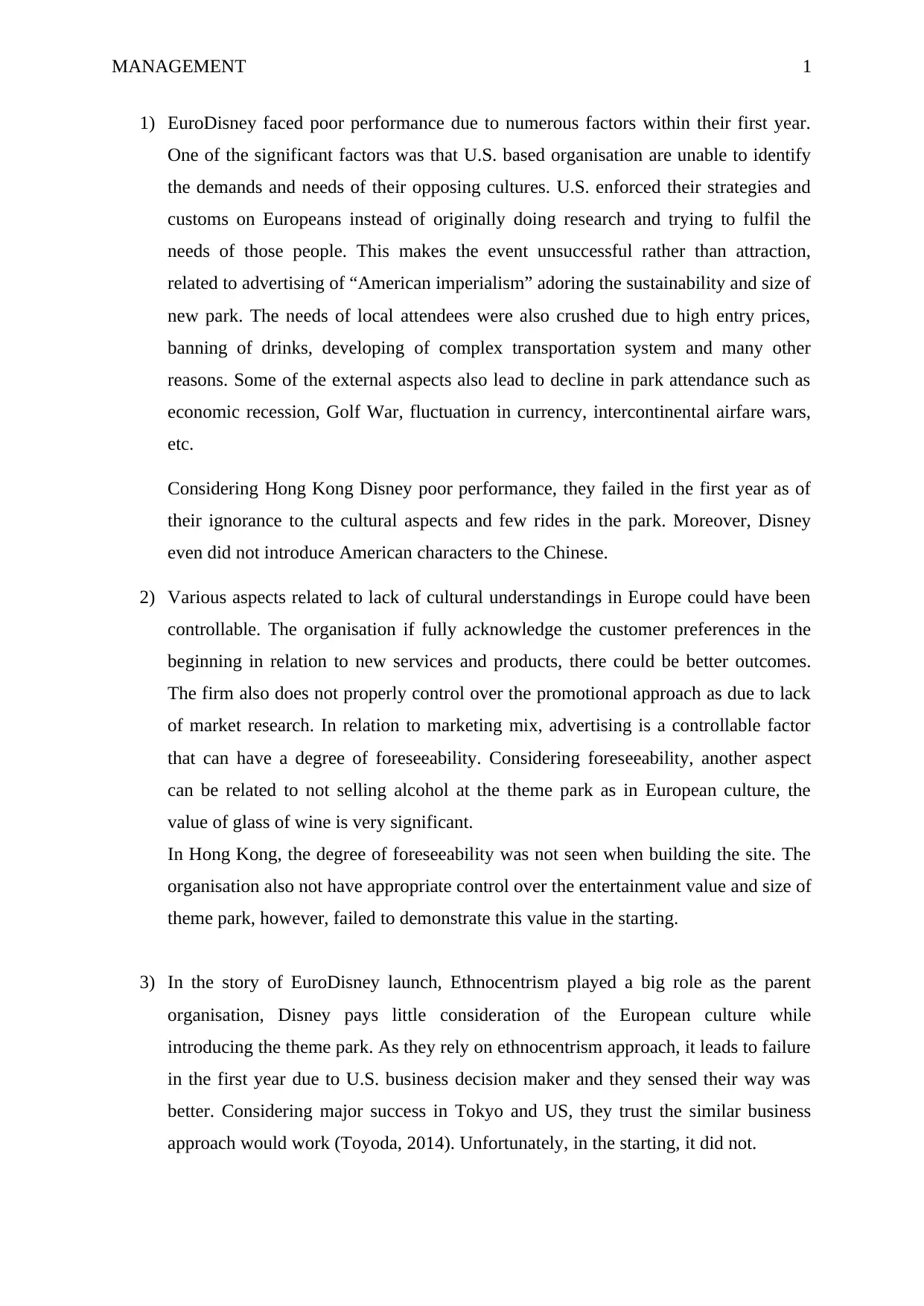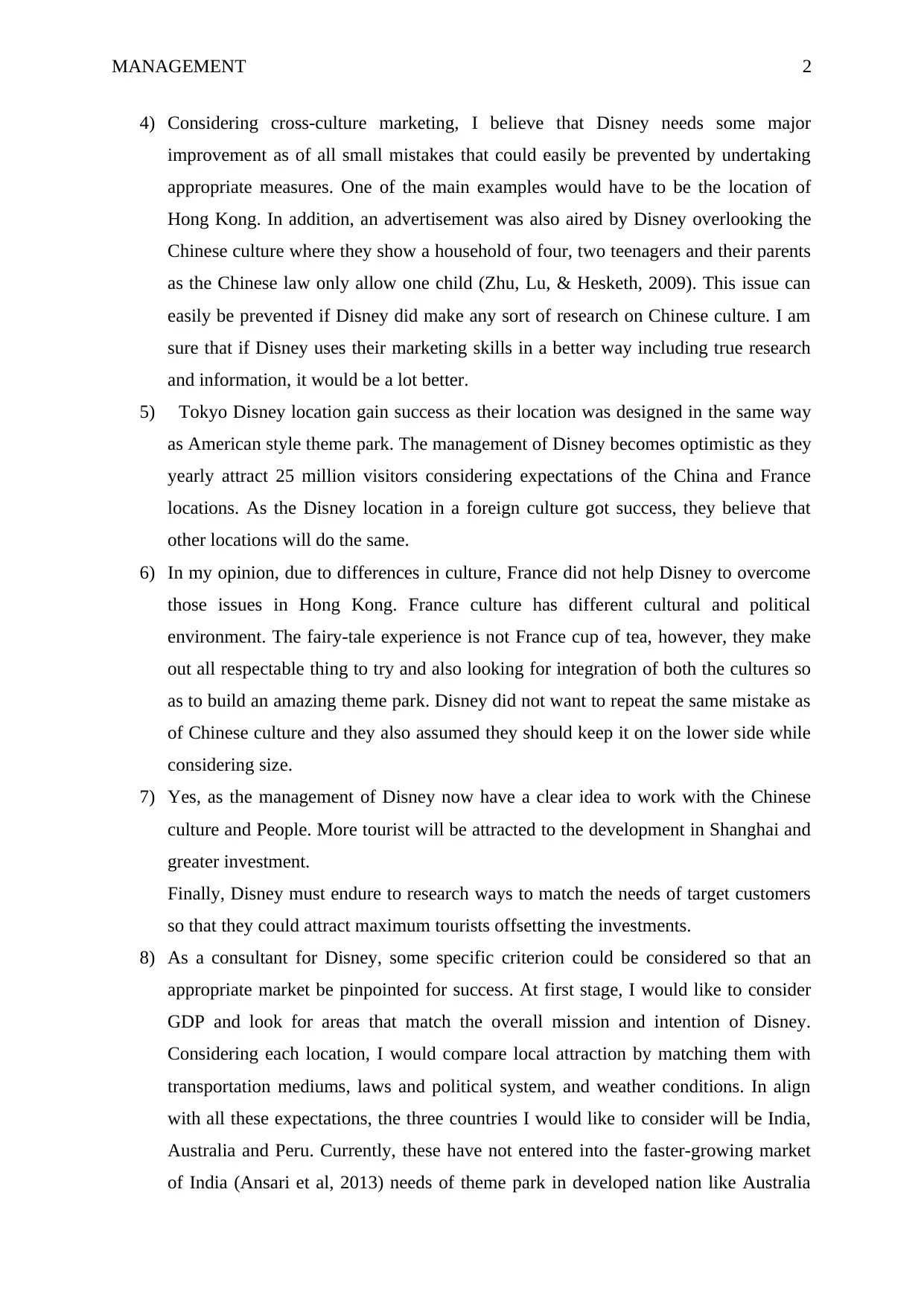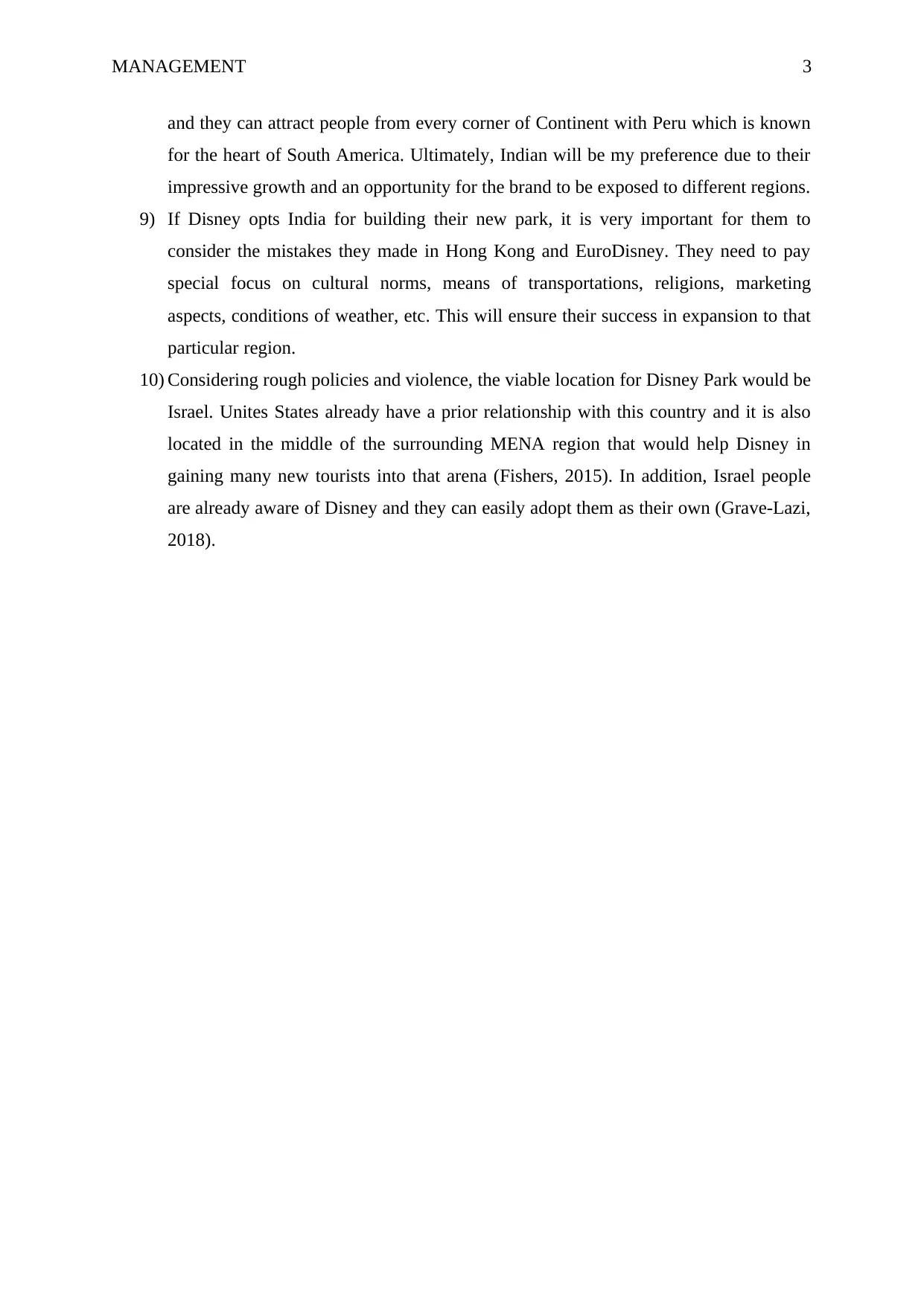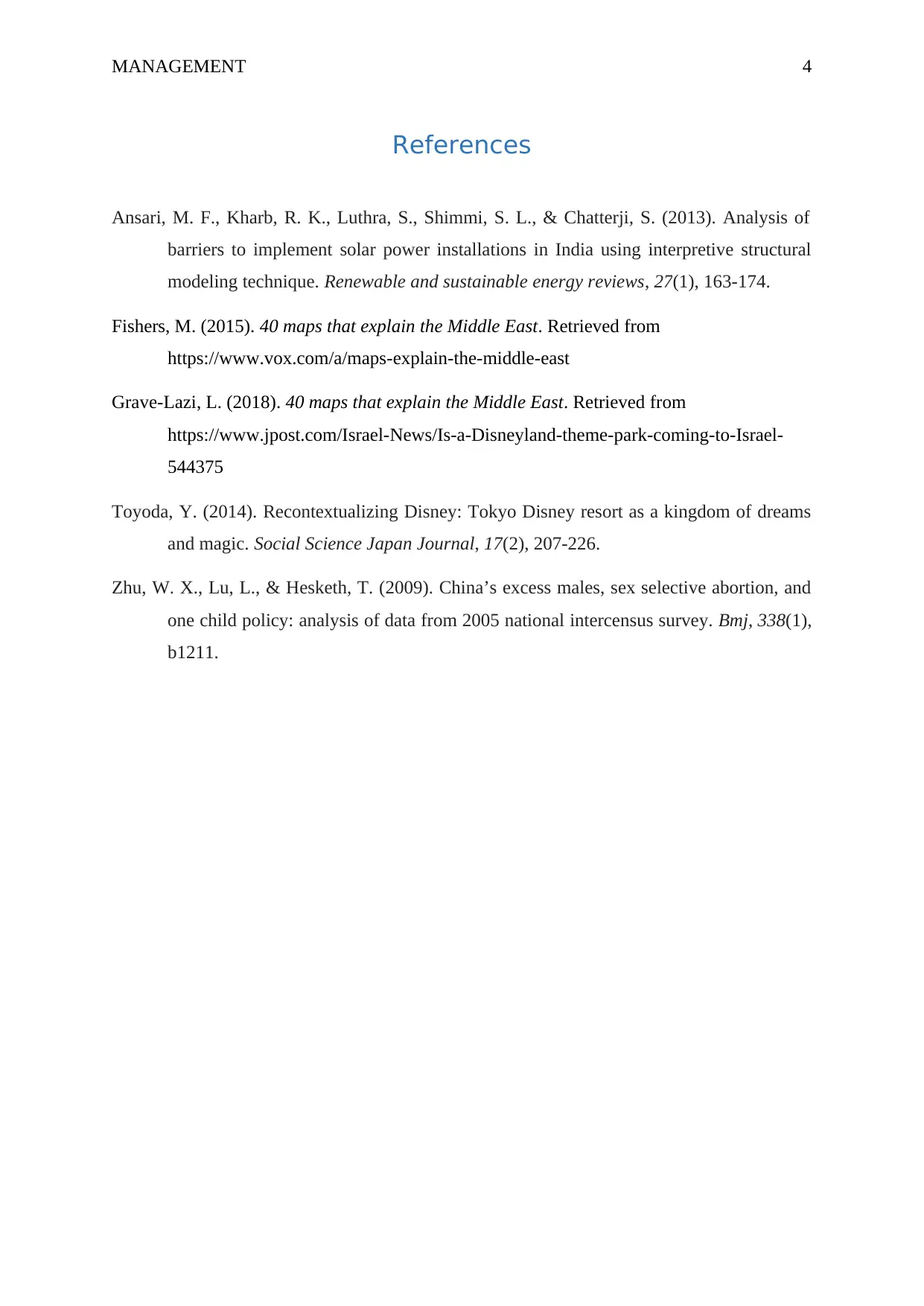EuroDisney's International Marketing Challenges and Solutions
VerifiedAdded on 2023/04/21
|5
|1314
|139
Case Study
AI Summary
This assignment examines the EuroDisney case study, focusing on the challenges the company faced in its initial years due to a lack of understanding of European culture. The analysis highlights the impact of ethnocentrism, high prices, and inappropriate marketing strategies on the park's performance. The case study explores specific failures, such as the pricing of hotels, the lack of cultural adaptation in marketing, and the failure to meet the expectations of the European market. The assignment also discusses potential solutions and alternative strategies Disney could have employed, including better market research, cultural sensitivity, and adjustments to the marketing mix. The analysis further considers the later successes of Tokyo Disneyland and the challenges faced in Hong Kong, concluding with recommendations for Disney's future international expansions, including potential locations like India and Israel, and the importance of adapting to local cultural norms, transportation, and marketing approaches.

MANAGEMENT 0
INTERNATIONAL MARKETING
INTERNATIONAL MARKETING
Paraphrase This Document
Need a fresh take? Get an instant paraphrase of this document with our AI Paraphraser

MANAGEMENT 1
1) EuroDisney faced poor performance due to numerous factors within their first year.
One of the significant factors was that U.S. based organisation are unable to identify
the demands and needs of their opposing cultures. U.S. enforced their strategies and
customs on Europeans instead of originally doing research and trying to fulfil the
needs of those people. This makes the event unsuccessful rather than attraction,
related to advertising of “American imperialism” adoring the sustainability and size of
new park. The needs of local attendees were also crushed due to high entry prices,
banning of drinks, developing of complex transportation system and many other
reasons. Some of the external aspects also lead to decline in park attendance such as
economic recession, Golf War, fluctuation in currency, intercontinental airfare wars,
etc.
Considering Hong Kong Disney poor performance, they failed in the first year as of
their ignorance to the cultural aspects and few rides in the park. Moreover, Disney
even did not introduce American characters to the Chinese.
2) Various aspects related to lack of cultural understandings in Europe could have been
controllable. The organisation if fully acknowledge the customer preferences in the
beginning in relation to new services and products, there could be better outcomes.
The firm also does not properly control over the promotional approach as due to lack
of market research. In relation to marketing mix, advertising is a controllable factor
that can have a degree of foreseeability. Considering foreseeability, another aspect
can be related to not selling alcohol at the theme park as in European culture, the
value of glass of wine is very significant.
In Hong Kong, the degree of foreseeability was not seen when building the site. The
organisation also not have appropriate control over the entertainment value and size of
theme park, however, failed to demonstrate this value in the starting.
3) In the story of EuroDisney launch, Ethnocentrism played a big role as the parent
organisation, Disney pays little consideration of the European culture while
introducing the theme park. As they rely on ethnocentrism approach, it leads to failure
in the first year due to U.S. business decision maker and they sensed their way was
better. Considering major success in Tokyo and US, they trust the similar business
approach would work (Toyoda, 2014). Unfortunately, in the starting, it did not.
1) EuroDisney faced poor performance due to numerous factors within their first year.
One of the significant factors was that U.S. based organisation are unable to identify
the demands and needs of their opposing cultures. U.S. enforced their strategies and
customs on Europeans instead of originally doing research and trying to fulfil the
needs of those people. This makes the event unsuccessful rather than attraction,
related to advertising of “American imperialism” adoring the sustainability and size of
new park. The needs of local attendees were also crushed due to high entry prices,
banning of drinks, developing of complex transportation system and many other
reasons. Some of the external aspects also lead to decline in park attendance such as
economic recession, Golf War, fluctuation in currency, intercontinental airfare wars,
etc.
Considering Hong Kong Disney poor performance, they failed in the first year as of
their ignorance to the cultural aspects and few rides in the park. Moreover, Disney
even did not introduce American characters to the Chinese.
2) Various aspects related to lack of cultural understandings in Europe could have been
controllable. The organisation if fully acknowledge the customer preferences in the
beginning in relation to new services and products, there could be better outcomes.
The firm also does not properly control over the promotional approach as due to lack
of market research. In relation to marketing mix, advertising is a controllable factor
that can have a degree of foreseeability. Considering foreseeability, another aspect
can be related to not selling alcohol at the theme park as in European culture, the
value of glass of wine is very significant.
In Hong Kong, the degree of foreseeability was not seen when building the site. The
organisation also not have appropriate control over the entertainment value and size of
theme park, however, failed to demonstrate this value in the starting.
3) In the story of EuroDisney launch, Ethnocentrism played a big role as the parent
organisation, Disney pays little consideration of the European culture while
introducing the theme park. As they rely on ethnocentrism approach, it leads to failure
in the first year due to U.S. business decision maker and they sensed their way was
better. Considering major success in Tokyo and US, they trust the similar business
approach would work (Toyoda, 2014). Unfortunately, in the starting, it did not.

MANAGEMENT 2
4) Considering cross-culture marketing, I believe that Disney needs some major
improvement as of all small mistakes that could easily be prevented by undertaking
appropriate measures. One of the main examples would have to be the location of
Hong Kong. In addition, an advertisement was also aired by Disney overlooking the
Chinese culture where they show a household of four, two teenagers and their parents
as the Chinese law only allow one child (Zhu, Lu, & Hesketh, 2009). This issue can
easily be prevented if Disney did make any sort of research on Chinese culture. I am
sure that if Disney uses their marketing skills in a better way including true research
and information, it would be a lot better.
5) Tokyo Disney location gain success as their location was designed in the same way
as American style theme park. The management of Disney becomes optimistic as they
yearly attract 25 million visitors considering expectations of the China and France
locations. As the Disney location in a foreign culture got success, they believe that
other locations will do the same.
6) In my opinion, due to differences in culture, France did not help Disney to overcome
those issues in Hong Kong. France culture has different cultural and political
environment. The fairy-tale experience is not France cup of tea, however, they make
out all respectable thing to try and also looking for integration of both the cultures so
as to build an amazing theme park. Disney did not want to repeat the same mistake as
of Chinese culture and they also assumed they should keep it on the lower side while
considering size.
7) Yes, as the management of Disney now have a clear idea to work with the Chinese
culture and People. More tourist will be attracted to the development in Shanghai and
greater investment.
Finally, Disney must endure to research ways to match the needs of target customers
so that they could attract maximum tourists offsetting the investments.
8) As a consultant for Disney, some specific criterion could be considered so that an
appropriate market be pinpointed for success. At first stage, I would like to consider
GDP and look for areas that match the overall mission and intention of Disney.
Considering each location, I would compare local attraction by matching them with
transportation mediums, laws and political system, and weather conditions. In align
with all these expectations, the three countries I would like to consider will be India,
Australia and Peru. Currently, these have not entered into the faster-growing market
of India (Ansari et al, 2013) needs of theme park in developed nation like Australia
4) Considering cross-culture marketing, I believe that Disney needs some major
improvement as of all small mistakes that could easily be prevented by undertaking
appropriate measures. One of the main examples would have to be the location of
Hong Kong. In addition, an advertisement was also aired by Disney overlooking the
Chinese culture where they show a household of four, two teenagers and their parents
as the Chinese law only allow one child (Zhu, Lu, & Hesketh, 2009). This issue can
easily be prevented if Disney did make any sort of research on Chinese culture. I am
sure that if Disney uses their marketing skills in a better way including true research
and information, it would be a lot better.
5) Tokyo Disney location gain success as their location was designed in the same way
as American style theme park. The management of Disney becomes optimistic as they
yearly attract 25 million visitors considering expectations of the China and France
locations. As the Disney location in a foreign culture got success, they believe that
other locations will do the same.
6) In my opinion, due to differences in culture, France did not help Disney to overcome
those issues in Hong Kong. France culture has different cultural and political
environment. The fairy-tale experience is not France cup of tea, however, they make
out all respectable thing to try and also looking for integration of both the cultures so
as to build an amazing theme park. Disney did not want to repeat the same mistake as
of Chinese culture and they also assumed they should keep it on the lower side while
considering size.
7) Yes, as the management of Disney now have a clear idea to work with the Chinese
culture and People. More tourist will be attracted to the development in Shanghai and
greater investment.
Finally, Disney must endure to research ways to match the needs of target customers
so that they could attract maximum tourists offsetting the investments.
8) As a consultant for Disney, some specific criterion could be considered so that an
appropriate market be pinpointed for success. At first stage, I would like to consider
GDP and look for areas that match the overall mission and intention of Disney.
Considering each location, I would compare local attraction by matching them with
transportation mediums, laws and political system, and weather conditions. In align
with all these expectations, the three countries I would like to consider will be India,
Australia and Peru. Currently, these have not entered into the faster-growing market
of India (Ansari et al, 2013) needs of theme park in developed nation like Australia
⊘ This is a preview!⊘
Do you want full access?
Subscribe today to unlock all pages.

Trusted by 1+ million students worldwide

MANAGEMENT 3
and they can attract people from every corner of Continent with Peru which is known
for the heart of South America. Ultimately, Indian will be my preference due to their
impressive growth and an opportunity for the brand to be exposed to different regions.
9) If Disney opts India for building their new park, it is very important for them to
consider the mistakes they made in Hong Kong and EuroDisney. They need to pay
special focus on cultural norms, means of transportations, religions, marketing
aspects, conditions of weather, etc. This will ensure their success in expansion to that
particular region.
10) Considering rough policies and violence, the viable location for Disney Park would be
Israel. Unites States already have a prior relationship with this country and it is also
located in the middle of the surrounding MENA region that would help Disney in
gaining many new tourists into that arena (Fishers, 2015). In addition, Israel people
are already aware of Disney and they can easily adopt them as their own (Grave-Lazi,
2018).
and they can attract people from every corner of Continent with Peru which is known
for the heart of South America. Ultimately, Indian will be my preference due to their
impressive growth and an opportunity for the brand to be exposed to different regions.
9) If Disney opts India for building their new park, it is very important for them to
consider the mistakes they made in Hong Kong and EuroDisney. They need to pay
special focus on cultural norms, means of transportations, religions, marketing
aspects, conditions of weather, etc. This will ensure their success in expansion to that
particular region.
10) Considering rough policies and violence, the viable location for Disney Park would be
Israel. Unites States already have a prior relationship with this country and it is also
located in the middle of the surrounding MENA region that would help Disney in
gaining many new tourists into that arena (Fishers, 2015). In addition, Israel people
are already aware of Disney and they can easily adopt them as their own (Grave-Lazi,
2018).
Paraphrase This Document
Need a fresh take? Get an instant paraphrase of this document with our AI Paraphraser

MANAGEMENT 4
References
Ansari, M. F., Kharb, R. K., Luthra, S., Shimmi, S. L., & Chatterji, S. (2013). Analysis of
barriers to implement solar power installations in India using interpretive structural
modeling technique. Renewable and sustainable energy reviews, 27(1), 163-174.
Fishers, M. (2015). 40 maps that explain the Middle East. Retrieved from
https://www.vox.com/a/maps-explain-the-middle-east
Grave-Lazi, L. (2018). 40 maps that explain the Middle East. Retrieved from
https://www.jpost.com/Israel-News/Is-a-Disneyland-theme-park-coming-to-Israel-
544375
Toyoda, Y. (2014). Recontextualizing Disney: Tokyo Disney resort as a kingdom of dreams
and magic. Social Science Japan Journal, 17(2), 207-226.
Zhu, W. X., Lu, L., & Hesketh, T. (2009). China’s excess males, sex selective abortion, and
one child policy: analysis of data from 2005 national intercensus survey. Bmj, 338(1),
b1211.
References
Ansari, M. F., Kharb, R. K., Luthra, S., Shimmi, S. L., & Chatterji, S. (2013). Analysis of
barriers to implement solar power installations in India using interpretive structural
modeling technique. Renewable and sustainable energy reviews, 27(1), 163-174.
Fishers, M. (2015). 40 maps that explain the Middle East. Retrieved from
https://www.vox.com/a/maps-explain-the-middle-east
Grave-Lazi, L. (2018). 40 maps that explain the Middle East. Retrieved from
https://www.jpost.com/Israel-News/Is-a-Disneyland-theme-park-coming-to-Israel-
544375
Toyoda, Y. (2014). Recontextualizing Disney: Tokyo Disney resort as a kingdom of dreams
and magic. Social Science Japan Journal, 17(2), 207-226.
Zhu, W. X., Lu, L., & Hesketh, T. (2009). China’s excess males, sex selective abortion, and
one child policy: analysis of data from 2005 national intercensus survey. Bmj, 338(1),
b1211.
1 out of 5
Your All-in-One AI-Powered Toolkit for Academic Success.
+13062052269
info@desklib.com
Available 24*7 on WhatsApp / Email
![[object Object]](/_next/static/media/star-bottom.7253800d.svg)
Unlock your academic potential
Copyright © 2020–2025 A2Z Services. All Rights Reserved. Developed and managed by ZUCOL.

